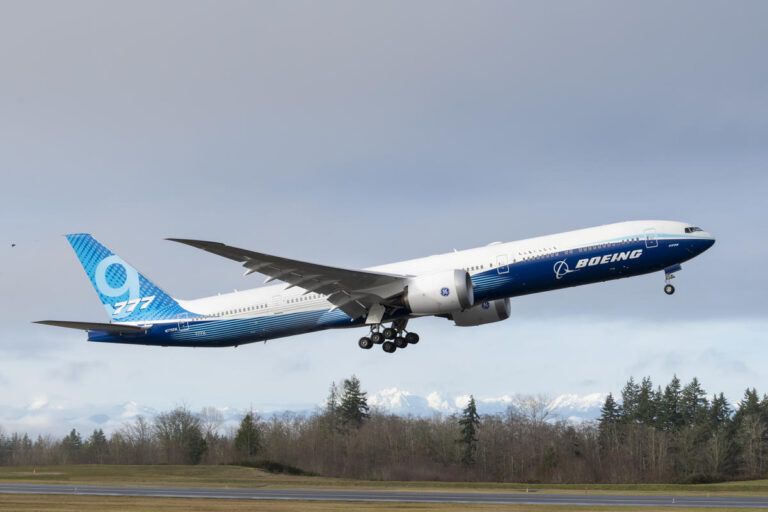Boeing’s latest airliner, the 777X, which is the largest twin-engined jet ever developed, made its maiden flight this weekend, signalling that aircraft is entering the next phase of its test program.
Test aircraft WH001 took off from Paine Field in Everett, Washington, at 10:09am local time on January 25 for a three hour, 51 minute flight over Washington state before landing at Seattle’s Boeing Field. The flight was postponed twice on January 23 and January 24 because of high winds.
WH001 is the first of four 777-9 flight test airplanes and will now undergo checks before resuming testing in the coming days. Ground testing of all the test aircraft began in Everett last year and will continue alongside flight testing over the coming months, said Boeing.
The 777X is Boeing’s first commercial jet to feature folding wingtips, which extend its wingspan from 212 ft (64.8 m) to 235 ft (71.8 m) while taking-off and in the air. The smaller wingspan of the 777X while on the ground enables the aircraft to fit in at airport gates and hangars that Boeing’s successful 777 widebody airliner currently uses, while enabling it to be larger than its predecessor.
Captain Van Chaney, 777/777X chief pilot for Boeing Test & Evaluation said, “The 777X flew beautifully, and today’s testing was very productive. Thank you to all the teams who made today possible. I can’t wait to go fly your airplane again.”
During the flight Chaney and Boeing chief pilot Craig Bomben worked through a test plan for the airplane’s systems and structures while a team in Seattle monitored the data in real time.
Stan Deal, president and CEO of Boeing Commercial Airplanes said, “Today’s safe first flight of the 777X is a tribute to the years of hard work and dedication from our teammates, our suppliers and our community partners in Washington state and across the globe.”
According to Boeing, the 777X twin-engined widebody commercial passenger jet will deliver 10% lower fuel use and emissions and 10% lower operating costs than comparable aircraft on the market thanks to improved aerodynamics, a carbon-fiber composite wing and the use of the GE Aviation’s GE9X, the world’s largest commercial jet engine. The 777X will compete with Airbus’ A350-1000.
The 777X includes the 777-8 and the 777-9, seating 384 and 426 passengers with ranges of 8,730 nautical miles (16,170 km) and 7,285 nautical miles (13,500 km) respectively. Airlines have ordered 340 777Xs and Boeing plans to deliver the first in 2021.
The successful first flight is an important milestone for Boeing at a time when the company is suffering badly from the continuing fallout from the 787 Max crashes in 2018 and 2019, which have grounded the existing fleet of aircraft and stopped production. The 777X program has also been delayed because of problems with the GE9X engine.
Development of the 777X started in 2013 and static testing of the aircraft started in September 2018.
For detailed information on the 777X and all other major commercial aircraft development programs go here.





